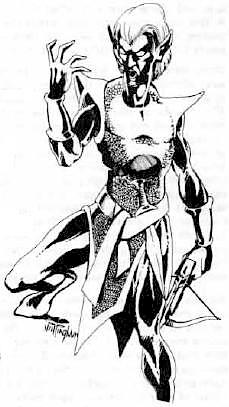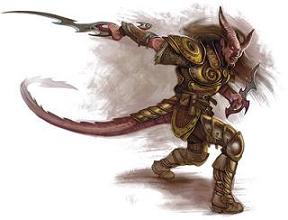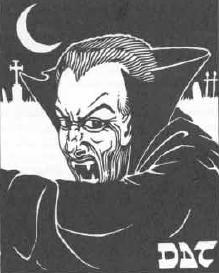
Babylonia was an ancient Akkadian-speaking state and cultural area based in the city of Babylon in central-southern Mesopotamia. It emerged as an Akkadian populated but Amorite-ruled state c. 1894 BC. During the reign of Hammurabi and afterwards, Babylonia was retrospectively called "the country of Akkad", a deliberate archaism in reference to the previous glory of the Akkadian Empire. It was often involved in rivalry with the older ethno-linguistically related state of Assyria in the north of Mesopotamia and Elam to the east in Ancient Iran. Babylonia briefly became the major power in the region after Hammurabi created a short-lived empire, succeeding the earlier Akkadian Empire, Third Dynasty of Ur, and Old Assyrian Empire. The Babylonian Empire rapidly fell apart after the death of Hammurabi and reverted to a small kingdom centered around the city of Babylon.

The drow or dark elves are a dark-skinned and white-haired subrace of elves connected to the subterranean Underdark in the Dungeons & Dragons fantasy roleplaying game. The drow have traditionally been portrayed as generally evil and connected to the evil spider goddess Lolth. However, later editions of Dungeons & Dragons have moved away from this portrayal and preassigned alignment. More recent publications have explored drow societies unconnected to Lolth.

In the Dungeons & Dragons fantasy role-playing game, illithids are monstrous humanoid aberrations with psionic powers. In a typical Dungeons & Dragons campaign setting, they live in the moist caverns and cities of the enormous Underdark. Illithids believe themselves to be the dominant species of the multiverse and use other intelligent creatures as thralls, slaves, and chattel. Illithids are well known for making thralls out of other intelligent creatures, as well as feasting on their brains.

Mesopotamian religion was the original religious beliefs and practices of the civilizations of ancient Mesopotamia, particularly Sumer, Akkad, Assyria and Babylonia between circa 6000 BC and 400 AD. The religious development of Mesopotamia and Mesopotamian culture in general, especially in the south, were not particularly influenced by the movements of the various peoples into and throughout the area. Rather, Mesopotamian religion was a consistent and coherent tradition, which adapted to the internal needs of its adherents over millennia of development.

In Akkadian mythology the Rabisu, or possibly Rabasa, are vampiric spirits, daimons, or demons. The Rabisu are associated in mythology with the Curse of Akkad. A consistent translation of "Rabisu" is “Lingerers”. The Rabisu, whether intending malicious actions or not, linger around those who have been found wayward or to be rewarded by the deity Enlil.

Halflings are a fictional race found in some fantasy works. They tend to be depicted as physically similar to humans, except about half as tall and not as stocky as the similarly sized dwarves. Halflings often have slightly pointed ears and feet covered with curly hair and with leathery soles. They tend to be portrayed as stealthy and lucky. The term is derived for the word used in Scotland, Northern Ireland, and Northern England for a child who is not yet fully grown. Halflings are found many fantasy novels and games, including as an alternative term for hobbits in J. R. R. Tolkien's Middle-earth and as playable humanoid races in Dungeons & Dragons.

The tiefling is a fictional humanoid race in the Dungeons & Dragons (D&D) fantasy roleplaying game. Originally introduced in the Planescape campaign setting in the second edition of Advanced Dungeons & Dragons as a player character race for the setting, they became one of the primary races available for player characters in the fourth edition of the game.
In the Dungeons & Dragons fantasy role-playing game, psionics are a form of supernatural power similar to, but distinct from, arcane and divine magic. Psionics are manifested purely by mental discipline. Psionics were introduced in the original supplement Eldritch Wizardry. Psionics have appeared as part of the core rules beginning with Advanced Dungeons & Dragons 1st edition.
Eberron is a campaign setting for the Dungeons & Dragons (D&D) role-playing game. The game is set primarily on the continent of Khorvaire following a vast destructive war. Eberron is designed to accommodate traditional D&D elements and races within a differently toned setting; Eberron combines a fantasy tone with pulp and dark adventure elements, and some non-traditional fantasy technologies such as trains, skyships, and mechanical beings which are all powered by magic.
The warforged are one of the playable fictional races of creatures in the Eberron campaign setting of the Dungeons & Dragons fantasy role-playing game.

Libris Mortis: The Book of Undead is a book which is an official supplement for the 3.5 edition of the Dungeons & Dragons role-playing game. The book covers the fictional undead within the D&D universe and comprises seven chapters, introducing new content for Dungeon Masters and players, as well as providing general information about undead.

In many works of modern fantasy, elves are depicted as a race or species of pointy-eared humanoid beings. These depictions arise from the álfar of Norse mythology influencing elves in fantasy as being semi-divine and of human stature, whose key traits are being friendly with nature and animals. However, this differs from Norse and the traditional elves found in Middle Ages folklore and Victorian era literature.

Vampires are frequently represented in popular culture across various forms of media, including appearances in ballet, films, literature, music, opera, theatre, paintings, and video games.
The cleric is one of the standard playable character class in the Dungeons & Dragons fantasy role-playing game. Clerics are versatile figures, both capable in combat and skilled in the use of divine magic (thaumaturgy). Clerics are powerful healers due to the large number of healing and curative magics available to them. With divinely-granted abilities over life or death, they are also able to repel or control undead creatures. Clerics also have specific 'domains' which usually align with the character's alignment and the god that cleric serves. Whether the cleric repels or controls undead is dependent on the cleric's alignment. It is the only class to be included in every edition of Dungeons & Dragons without a name change.

The elf is a humanoid race in the Dungeons & Dragons fantasy role-playing game, one of the primary races available for player characters, and play a central role in the narratives of many setting worlds of the game. Elves are described as renowned for their grace and mastery of magic and weapons such as the bow and sword. Becoming physically mature by the age of 25 and emotionally mature at around 125, they are also famously long-lived, capable of living more than half a millennium and remaining physically youthful. Possessed of innate beauty and easy gracefulness, they are viewed as both wondrous and haughty by other races in-universe; however, their natural detachment is seen by some as introversion or xenophobia. They were usually portrayed as antagonistic towards dwarves.

Kobolds are a fictional race of humanoid creatures featured in the Dungeons & Dragons roleplaying game and other fantasy media. They are often depicted as small reptilian humanoids with long tails, distantly related to dragons.

In the Dungeons & Dragons fantasy role-playing game, a vampire is an undead creature. A humanoid or monstrous humanoid creature can become a vampire, and looks as it did in life, with pale skin, haunting red eyes, and a feral cast to its features. A new vampire is created when another vampire drains the life out of a living creature. Its depiction is related to those in the 1930s and 1940s Hollywood Dracula and monster movies. In writing vampires into the game, as with other creatures arising in folklore, the authors had to consider what elements arising in more recent popular culture should be incorporated into their description and characteristics.
The role-playing game Dungeons & Dragons (D&D), which receives significant attention in the media and in popular culture, has been the subject of numerous controversies. The game sometimes received unfavorable coverage, especially during its early years in the early 1980s. Because the term D&D may be mistakenly used to refer to all types of role-playing games, some controversies regarding D&D mistakenly pertain to role-playing games in general, or to the literary genre of fantasy. Some controversies concern the game and its alleged impact on those who play it, while others concern business issues at the game's original publisher, TSR. The game is now owned by Wizards of the Coast.
There are many references to ghosts in ancient Mesopotamian religion – the religions of Sumer, Babylon, Assyria and other early states in Mesopotamia. Traces of these beliefs survive in the later Abrahamic religions that came to dominate the region.









